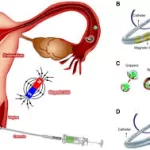Recent research conducted by scientists at the University of New Mexico Health Sciences has revealed the presence of microplastics in human placentas, highlighting potential health risks associated with exposure to these ubiquitous pollutants. The findings, published in the journal Toxicological Sciences, underscore the need for further investigation into the health effects of microplastic contamination.
Led by Dr. Matthew Campen, a team of researchers analyzed placenta samples from 62 individuals, detecting microplastics in all samples tested. Using a novel analytical technique, the researchers quantified microplastic concentrations ranging from 6.5 to 790 micrograms per gram of tissue. Despite the seemingly small quantities, the widespread presence of microplastics in human placentas raises concerns about potential health implications.
Dr. Campen expressed worry about the escalating levels of microplastics in the environment and their potential impact on human health. As plastic production continues to rise exponentially, microplastics have become pervasive in our surroundings, infiltrating everything from bottled water to food products. The accumulation of these particles in human tissue, including the placenta, poses significant health risks, according to Dr. Campen.
The study employed innovative analytical methods to detect and characterize microplastics in placental tissue. By chemically treating the samples and subjecting them to high temperatures, the researchers were able to identify and quantify various types of plastic polymers present in the tissue. Polyethylene, commonly used in plastic bags and bottles, emerged as the most prevalent polymer, comprising over half of the total plastics detected.
Marcus Garcia, a postdoctoral fellow involved in the study, emphasized the importance of accurately quantifying microplastic concentrations in human tissue. Traditional methods of particle counting may underestimate the true extent of microplastic contamination, particularly when dealing with particles too small to be observed under a microscope. The new analytical approach provides a more precise assessment of microplastic levels, enabling researchers to better understand their potential health effects.
While the health implications of microplastic exposure remain uncertain, Dr. Campen cautioned against overlooking the potential risks. Microplastics, particularly those of nanometer size, have the ability to penetrate cell membranes and accumulate in various organs and tissues. Their presence in human placentas, a vital organ crucial for fetal development, raises concerns about prenatal exposure and its impact on maternal and fetal health.
Dr. Campen and his team are committed to further investigating the health effects of microplastics and exploring potential links to various health conditions, including inflammatory bowel disease, colon cancer, and declining sperm counts. As plastic production continues unabated, Dr. Campen emphasized the urgent need for action to mitigate the growing threat posed by microplastic pollution.
The study serves as a wake-up call, highlighting the urgent need for concerted efforts to address the proliferation of plastic pollution and safeguard human health against its detrimental effects. Without decisive action, the pervasive presence of microplastics in our environment threatens to exacerbate existing health challenges and pose new risks to future generations.











